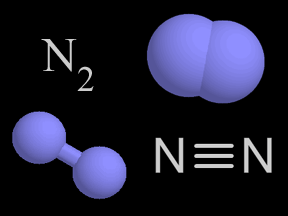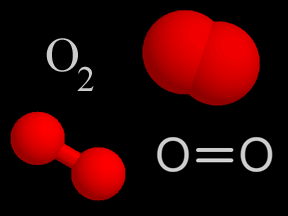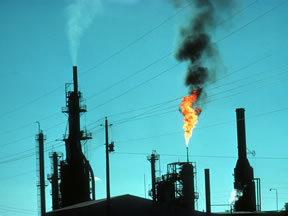Here are four different ways that chemists use to show a molecule of nitric acid. In the colored molecule models, nitrogen is blue, oxygen is red, and hydrogen is white.
Click on image for full size
Windows to the Universe original artwork by Randy Russell.
Nitric Acid - HNO3
Nitric acid is a very strong acid that can burn your skin. Nitric acid has nitrogen, oxygen, and hydrogen atoms in it. There is a very tiny bit of nitric acid gas in Earth's atmosphere.
Nitric acid is one of the acids in acid rain. Polluted air has much more nitric acid in it than clean air. Car and truck engines make chemicals called nitrogen oxides when they burn their fuel. When nitrogen oxides mix with water vapor in the air, they turn into nitric acid. This nitric acid falls from the sky as acid rain.
People use nitric acid for lots of things. It is used to make fertilizer. It is also used to make explosives, like nitroglycerin and TNT. The acid is used to make patterns and designs on glass and metal, including jewelry. Nitric acid is also used in some types of liquid fueled rockets!
You might also be interested in:

There is more nitrogen gas in the air than any other kind of gas. About 4/5ths of Earth's atmosphere is nitrogen gas! A molecule of nitrogen gas is made up of two nitrogen atoms. There are other molecules
...more
Oxygen (O2) is a kind of gas. A lot of the air you breathe is oxygen. That's a good thing, since we need oxygen to stay alive! About 4/5ths of the air in Earth's atmosphere is nitrogen (N2). Almost all
...more
Acid rain is a general term used to describe different kinds of acidic air pollution. Although some acidic air pollutants return directly back to Earth, a lot of it returns in rain, snow, sleet, hail,
...more
What do smog, acid rain, carbon monoxide, fossil fuel exhausts, and tropospheric ozone have in common? They are all examples of air pollution. Air pollution is not new. As far back as the 13 th century,
...more
Air pollution comes from many different sources. Natural processes that affect air quality include volcanoes, which produce sulfur, chlorine, and ash particulates. Wildfires produce smoke and carbon monoxide.
...more
Have you heard about rivers, lakes, or streams becoming polluted? Sometimes the pollution comes from trash, oil spills, sewage, fertilizers, or chemicals. However, sometimes the source of water pollution
...more
When you think of chemistry, do you think about mixing colored liquids in test tubes and maybe making an explosion... or at least a nice puff of smoke? Did you know that a lot of chemistry happens in Earth's
...more















